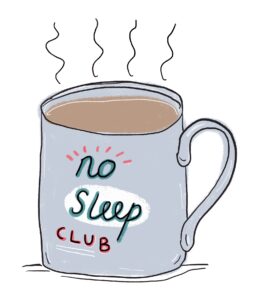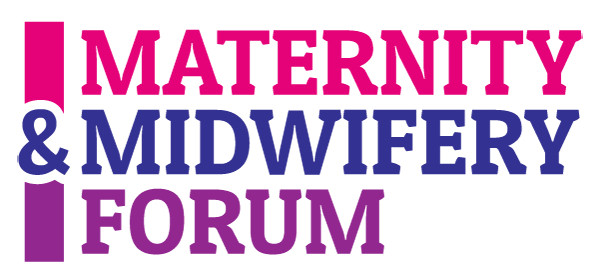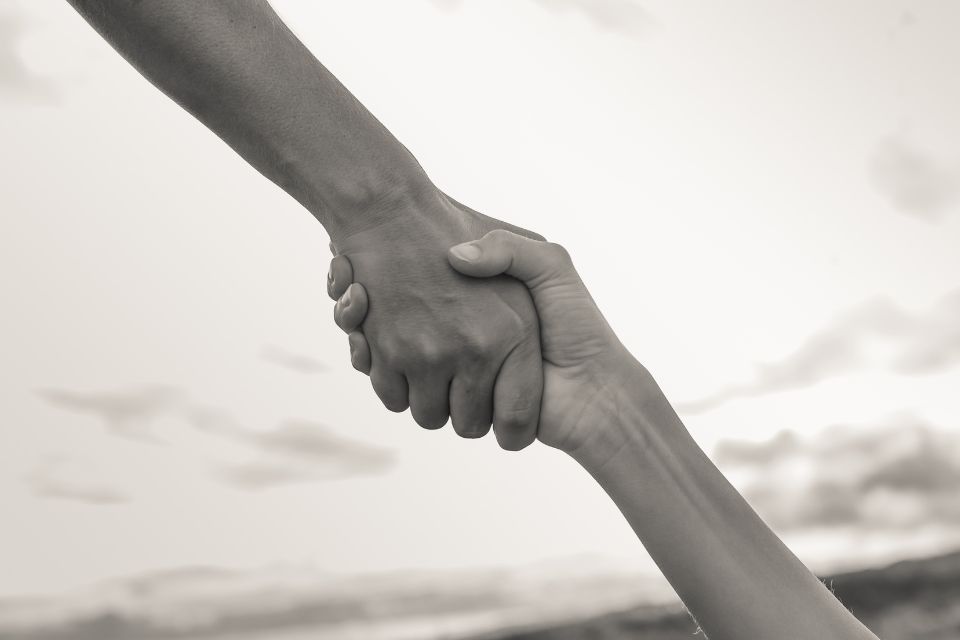April is targeted as Stress Awareness month, though we know stressful environments and situations can occur throughout the year! Kate Greenstock, Midwife, Coach (CPCC, PCC) and Author of Flourish: A Practical and Emotional Guidebook to Thriving in Midwifery, discusses burnout, trauma and stress, offering some pointers to combat the impact.
_________________________________________________
So here we are again in the midst of stress awareness month, and on the cusp of celebrating International Day of the Midwife 2025. There is much to celebrate in the global world of midwifery, despite the challenges. And yet our handling of stress is not an area we can congratulate ourselves over.
Following a long legacy of starched and stoical nursing practice, as midwives we have been compared to swans gliding along the surface of someone else’s pain, but with our own feet desperately paddling away under the surface (Scamell, 2011).
And that paddling is not just required for the ever increasingly complex range of tasks and emotional care needed in the moment, but for ourselves: keep moving, keep talking, keep smiling, keep caffeinated. Slowing down, after all could be fatal.
As Dr Andrew Tressider points out in the brilliant ‘I am not a frog’ podcast curated by ex-GP Rachel Morris, our adrenal systems are on overdrive. This is not helped by (still) persistent narratives which celebrate the warrior or superhero health care worker who neglects their own needs in the process of caring for others.

This ultimately produces a vigilance that is hard to switch off, our adrenal glands working overtime, attempting to maintain a state of alertness for flight, fight or freeze, whatever the ‘immediate threat’ requires. In this state we lose perspective, tending to drive harder or work harder to compensate for the way we feel, compounding the problem (Greenstock, 2023). Our window of tolerance is reduced (Siegel,1999), making us more vulnerable to tipping into hyperarousal: anxiety, emotional flooding, difficulty sleeping or digesting or hypoarousal, a state of shutting down or dissociating linked to exhaustion, depression and numbing behaviours (including excessive scrolling, and bed rotting, neither of which are actually restorative). Tressider (2019) reminds us that before any emotional mental health diagnosis is considered for healthcare professionals, we need to prescribe deep rest and deep recognition of what is happening physiologically.
So let’s talk about burnout as a symptom of stress. The word burnout is often used as shorthand for ‘excessively tired’, in a state or adrenal overload: what Van Dernoot Lipsky (2009) calls a ‘bone-tired, soul-tired, heart-tired kind of exhaustion’. It is also sometimes used to describe the experience of compassion fatigue where we have ‘nothing left to give’ to families in our care or frankly to our own families or friends. I’m ‘just a bit burnt out’ we say, describing a hollowed-out state. Yet as Gina Finnerty so beautifully described in her Maternity & Midwifery Forum article in March 2025 , burnout is a classified occupational disease (WHO, 2019), has a higher than average prevalence in midwives (Hunter et al, 2019; Matthews, 2023), and can be anticipated and calibrated. We can see it coming, but only if we know how to look. And how to look depends on having the shared language we need to define feelings and stages, and having the tools to classify where we are on the scale (Hadzibajramovic et al 2022). We then need integrated, regular ways of checking in to identify what we need now to reduce our chances of greater suffering later (Soria et al, 2024).
Burnout, as midwife and writer Leah Hazard once said is not created by one ‘sudden fiery blaze but a series of burning fires over time’ (Hazard, 2019). Two of those burning fires in the hearts and mind of midwives are moral injury and ongoing trauma exposure – both of which are hard to avoid.
One of the reasons I wrote the book Flourish: a practical and emotional guidebook to thriving in midwifery was to give midwives a shared vocabulary to comprehend these experiences and feelings. In short, moral injury (as many of you now know) is the experience of being unable to meet our foundational principles of ‘first do no harm’ or in midwifery terms, first be truly ‘with woman or birthing person’. It shows up when we are asked to work against our own values, or feel powerless to prevent harm: facilitating an unnecessary induction of labour for example, or medical intervention in the second stage of labour according solely to predetermined time protocols. In short this is a moral and mental burden creating a stress response in the body and mind.
Trauma exposure is exactly what it says on the tin. Except ‘traumatisation’ is often regarded as triggered by the more dramatic events, those regarded as objectively ‘traumatic’. What we know from all round human experience and from women and birthing people of course is that trauma is in the eye of the beholder, can be triggered by previous life experience, and tends to be cumulative, building stress in small ways until a midwife starts to experience the symptoms of burnout or compassion fatigue: unable any longer to connect their heart to the work or to the person. The ‘everyday’ things are often disregarded as a ‘normal’ part of midwifery culture, which is a form of gaslighting linked to the super hero narrative: “we toughen up, it’s how we do it…. right?” Yet the bricks of the house of ongoing trauma exposure are stories of people’s challenging lives, exposure in the corridor to another description of a heavily interventionist birth, yet another experience of moral injury, powerless in the moment to prevent coercion or harm.
So how can we reduce the impact of the stress that comes from these challenges and realities? Some of the following points are for us as individuals, most are about collective action. Resilience is not an individual trait or action (Hunter and Warren, 2022) is only possible with structural and systemic support and change.
Seven ideas spell G E T H E L P here –
- Get briefed. Flourish (www.flourishformidwives.com) is a map helping you to continue your midwifery journey with
– a robust understanding and vocabulary around the psychological dimensions of midwifery care
– a toolkit of resources to support you with your mind, body, breath, your sense of purpose as a midwife and your ability to influence change
- Expect collective care – if you’re in the UK, either as a 3rd year student midwife or band 6 midwife changing NHS Trusts, actively ask what exactly the maternity department are doing to tackle the impact of stress on midwives. Don’t accept well-being days as a meaningful answer (well-intentioned and morale building as they might be). Get curious about the availability of
– psychological support – particularly dedicated maternity support (Hüner et al,2024)
– commitment to reflective time
– empowering rostering practices
– practices and rituals building teams even in a fractured rotational model
– intentionally compassionate handovers
– thoughtful, listening leadership and receptiveness to innovation at all levels (Smith, 2021)
- Tell others what you are experiencing. One of the most empowering things we did as a group of newly qualified midwives during the height of the Covid pandemic was to gather online and set the conditions for sharing deeply. I have a pervasive memory of sitting in late winter-evening darkened rooms on afternoons off, feeling heard and seen.
- Hold leaders-in-the-hierarchy to account. This need not be from an embattled place, but from a place of partnership. Read my love letter to midwifery leaders from Flourish for inspiration.
- Elevate the status of midwifery in your mind and spirit by focusing on the moments of power rather than powerlessness (see reflective time above)
- Limit exposure to narratives of ‘it’s just the way it is’. Instead find your ‘tribe’ – people who care about making the same tiny but powerful changes as you. Then proactively care for (and motivate) each other.
- Prioritise connection in small ways to others and to yourself. The NHS itself places this at the top of its 5 ways to wellbeing
After all, systemically-driven collective care and personal connection are the best possible antidotes we have to stress. You are ‘cut out for this’. The system is just not yet cut out for you.

Images by Jo Bradshaw.
References
Finnerty, G. (2019) Spotlight on recognising and reducing burnout in the workplace https://maternityandmidwifery.co.uk/spotlight-on-recognising-and-reducing-burnout-in-the-workplace/
Greenstock, K. (2023) Flourish. A practical and emotional guidebook to thriving in midwifery London: Pinter and Martin
Hadzibajramovic, E, Hansson M, Skerstrom M, et al (2022) Burnout among midwives-a factorial structure of the burnout assessment tool and an assessment of burnout levels in a Swedish national sample BMC Health Services Research 22:1167 https://bmchealthservres.biomedcentral.com/articles/10.1186/s12913-022-08552-8
Hazard, L. (2019) Emma Gannon Ctrl Alt Delete podcast #213 Leah Hazard: Burnout in the NHS. 22 Aug 2019 https://podtail.com/en/podcast/ctrl-alt-delete/-213-leah-hazard-burnout-in-the-nhs/
Hüner B, Friedl T, Schütze S, et al (2024) Post-traumatic stress syndromes following childbirth influenced by birth mode-is an emergency cesarean section worst? Arch Gynecol Obstet. 309(6):2439-2446. doi: 10.1007/s00404-023-07114-5.
Hunter, B, Fenwick, J, Sidebotham M, Henley J (2019) Midwives in the United Kingdom: Levels of burnout, depression, anxiety and stress and associated predictors Midwifery 79, 102526
Hunter, B, Warren, L. (2022) Revisiting Resilience. The Practising Midwife 25:9– 13
Kendall-Tackett, K, Beck, C. (2022) Secondary Traumatic Stress and Moral Injury in Maternity Care Providers: A Narrative and Exploratory Review. Frontiers in Global Women’s Health Vol 3 https://doi.org/10.3389/fgwh.2022.835811
Matthews, R. (2023) Future-proofing the midwifery profession in Victoria: Sustainability, health and wellbeing of Victorian midwives. Australian College of Midwives 32 (1) 10-15
Siegel, D.J. (1999)The Developing Mind: How Relationships and the Brain Interact to Shape Who We Are The Guilford Press https://drdansiegel.com/book/the-developing-mind/
Scamell, M. (2011) The swan effect in midwifery talk and practice: a tension between normality and the language of risk: Sociol Health Illn 33(7):987–1001. http://dx.doi.org/10.1111/j.1467-9566.2011.01366.x
Smith, J. (2021) ‘Nurturing Maternity Staff; How to tackle trauma, stress and burnout to create a positive working culture in the NHS’ London: Pinter & Martin
Soria J, Zervoulis K, Bolou A (2024) A survey examining the relationship between burnout, professional empowerment and personality traits of midwives of an inner London NHS Trust European Journal of Midwifery 8 (13)
Tresidder A. (2019) Denial, displacement and other ways we neglect ourselves with Dr Andrew Tresidder. You are not a Frog podcast Episode 77 with Dr Rachel Morris. https://youarenotafrog.com/episodes/77/
van Dernoot Lipsky L, Burk C. (2009) Trauma stewardship: An everyday guide to caring for self while caring for others. San Francisco, CA: Berrett-Koehler
World Health Organization (2019) Burnout an “occupational phenomenon”: International Classification of Diseases. Geneva: World Health Organization; 2019. https://www.who.int/news/item/28-05-2019-burn-out-an-occupational-phenomenon-international-classification-of-diseases
Kate Greenstock
Midwife, Coach (CPCC, PCC) and Author of Flourish: A Practical and Emotional Guidebook to Thriving in Midwifery
March 2025


